Redesigned 2025 Toyota 4Runner Is Larger and More Powerful Than Ever
Off-road-focused SUV gains myriad upgrades to aid both adventures and commutes
True to its roots, the redesigned 2025 Toyota 4Runner is an off-road-capable SUV spun off a platform shared with the latest Tacoma, Land Cruiser, and other body-on-frame Toyota models.
Larger than before, the new 4Runner is the same length bumper to bumper as a Highlander, making it an inch longer than the upcoming Land Cruiser. The wheelbase is the same as both of those models, at 112 inches.
- Toyota 4Runner: CR's Take Outside Inside What Drives It Active Safety and Driver Assistance
This sixth-generation 4Runner shares powertrains with the Tacoma, offering a choice of two turbocharged four-cylinder engines—with one being a potent hybrid.
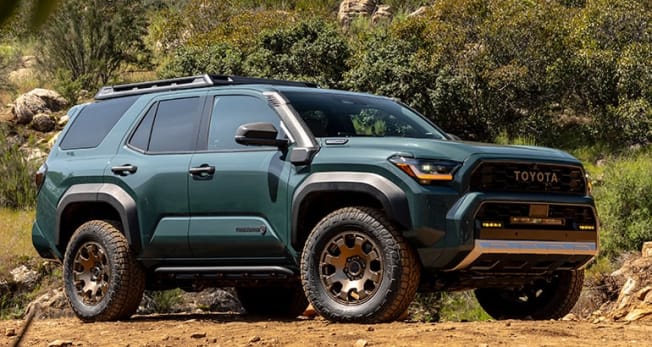
Photo: Toyota Photo: Toyota
CR's Take
Despite being last redesigned for the 2010 model year, the 4Runner has remained relatively popular, serving adventurous drivers who also prize reliability. Light updates over time added tech and safety features, but the 4Runner has long been in need of a full overhaul.
Even with solid sales numbers, the current 4Runner’s clumsy handling, unsettled ride, awkward access, low ceiling and tight interior space, and loud engine noise have seen the popular SUV fall out of step with the market. This is an important opportunity to catch up.
Many of those criticisms were shared with the prior Tacoma, and the new truck has seen significant improvements, based on our experience thus far. Front access and the driving position are much better, for example. This bodes well for the 4Runner, whose main mission is to satisfy its loyal fanbase and perhaps even draw customers away from other dirt-ready models, like the Ford Bronco and Jeep Wrangler. With gains in civility, it may also attract buyers looking for an SUV that better fits their outdoor lifestyle—or aspirations.
The larger dimensions may bring welcome improvements to access, passenger space, and cargo room; we look forward to discovering how the specs translate into real-world benefits.
The engines mark an important upgrade, bringing more power and potentially improved efficiency, aided by the turbochargers and added transmission gears. The hybrid, as in other Toyota truck-based models, is meant to bring greater power while minimizing a fuel economy trade-off, rather than achieving peak efficiency like most hybrid cars. The 2024 4Runner returned just 17 mpg overall, so there is clear room for improvement.
We experienced the 4Runner’s base engine in a Tacoma, where it sounded strong and powerful, but the gritty, aural soundtrack wasn’t so pleasant. The engine character was decidedly trucky, and we expect that will be the case here too.
Overall, the 4Runner promises to improve on its premise, bringing enhancements across the board and delivering them in a more modern package.
Outside
The 4Runner is demonstrably larger than before, gaining 5 inches in overall length (194.9 inches), 2 inches in width (77.8 inches), and losing about an inch in height (70.8 inches). The ground clearance is a tall 9.2 inches.
By the measuring tape, the 4Runner is the same length as a Highlander, but its roof is about 3 inches taller. That makes it a rather sizable vehicle, particularly one with short overhangs front and rear—a design that aids approach and departure angles for off-roading.
The 4Runner bears a close resemblance to the Tacoma, while preserving some proportions and styling elements long associated with the SUV. There are more design differences between the two vehicles as you study them, but at a glance, they are clearly siblings.
Among the design elements, the rear corner windows, angled C-pillar behind the rear doors, and roll-down rear glass are key nostalgic cues. An interesting design embellishment: the rear quarter windows wrap into the roof.
The body has many complex shapes, with folds, bulges, and creases that catch the light in different ways. In looking at photos of the 4Runner in the wild, on trails, one can’t help but wonder about challenges in body repair from misadventures.

Photo: Toyota Photo: Toyota
Inside
The cabin mirrors the design used in the Tacoma, giving it a more rugged appearance than the current 4Runner.
We found that this layout in the Tacoma benefits from big, glove-friendly buttons, knobs, and switches. Common features are clearly labeled and easy to operate. It’s notable that every control is plainly visible, even the engine stop/start button.
Lower trims feature a 7-inch digital gauge cluster for the driver, while higher trims get a 12.3-inch screen. A head-up display is available on top trims.
The center infotainment screen dominates the dash, with the vents now being lower and rather subtle. The base touchscreen measures 8 inches, and there is an available 14-inch screen that stands out like a laptop monitor perched on the dash. These displays house the latest Toyota multimedia system that debuted on the 2022 Tundra.
It is compatible with Android Auto and Apple CarPlay, and a wireless Qi charge pad for phones is available. There are several USB ports in the cabin as well.
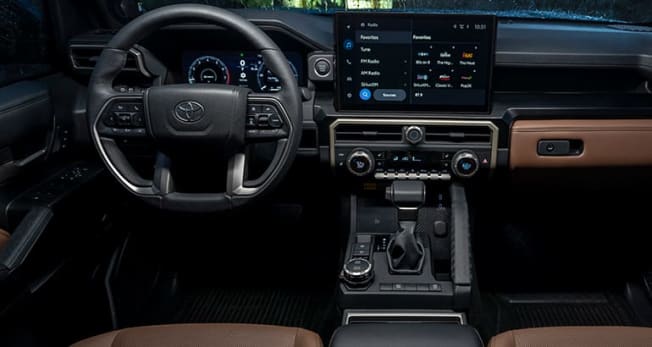
Photo: Toyota Photo: Toyota
There is a JBL stereo upgrade, with a portable speaker that serves as the center channel when mounted in the dash. This JBL Flex speaker can be removed and used via Bluetooth at the beach, campground, or worksite.
A digital key is available on some higher trims that allows a smartphone to unlock/lock and start the SUV. Access can be shared with other drivers via a phone as well.
The second-row seats tumble forward to increase cargo space. On the Platinum trim, the second-row seat is heated.
Once again, a third-row seat is available. Presumably, the vehicle’s larger size this generation will bring much-needed additional space for rearmost passengers.
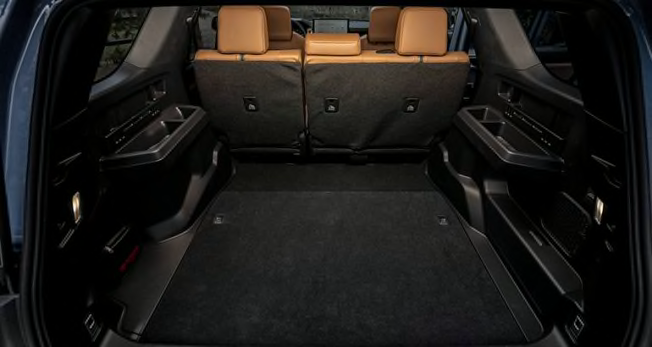
Photo: Toyota Photo: Toyota
What Drives It
There are two turbocharged, four-cylinder engines offered, each with an eight-speed automatic transmission. (The previous 4Runner used a five-speed automatic.)
The base engine produces more horsepower and torque than the previous V6, rated at 278 hp and 317 lb.-ft. of torque, respectively. This is the power plant for the SR5, TRD Sport, and TRD Sport Premium.
Stepping up to higher trims brings the i-Force Max hybrid engine, which integrates a 48-hp electric motor into the powertrain. This combination boasts 326 hp and 465 lb.-ft. of torque, giving the SUV a maximum tow capacity of 6,000 pounds.
The 4Runner can be had in two-, four-, and full-time four-wheel drive. The full-time four-wheel-drive setup is available on Limited and standard on Platinum. An electronic locking rear differential is standard on TRD Off-Road, TRD Pro, and Trailhunter trims.
To aid traction in challenging conditions, the driver can choose settings such as Mud, Dirt, and Sand from the Multi-Terrain Select system in either 4WD-High or 4WD-Low.
Toyota claims the latest version of its Crawl Control function—low-speed cruise control for off-roading—is quieter. (The previous rendition had so much brake noise that it might discourage some from using this handy feature.) There is also a hill descent control feature for off-roading.
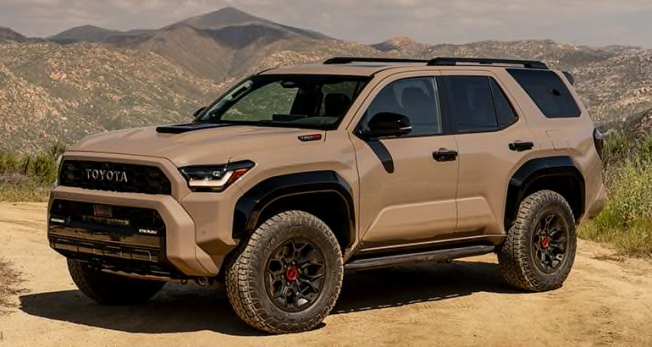
Photo: Toyota Photo: Toyota
Active Safety and Driver Assistance
Toyota Safety Sense 3.0 is standard on all 4Runners, bundling a full suite of active safety and convenience features. These include automatic emergency braking with pedestrian detection, lane departure warning, lane centering assistance, adaptive cruise control, automatic high beams, and road sign assist. Blind spot warning and rear cross traffic warning are also standard.
Toyota’s Proactive Driving Assist system provides light braking and steering assistance when entering turns, and helps for reacting to other vehicles, cyclists, and pedestrians. By monitoring driver inputs, such as engagement with steering, the truck can alert an inattentive driver or bring the vehicle to a stop, such as during a medical emergency.
To aid towing, there is a tow package available. Options are expected to be similar to the Tacoma with an available trailer brake controller, trailer backup guide, video rearview mirror, a surround view camera, and trailer assistance to aid in backing up with a trailer hitched.

Photo: Toyota Photo: Toyota
















